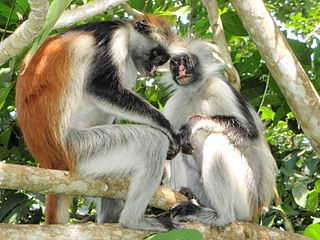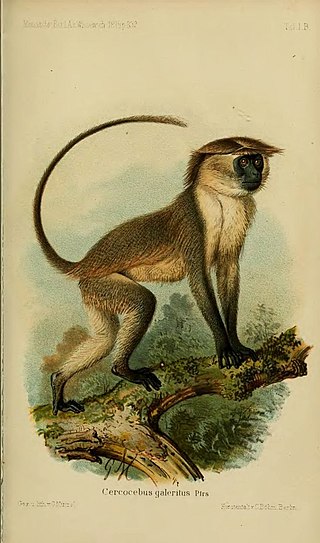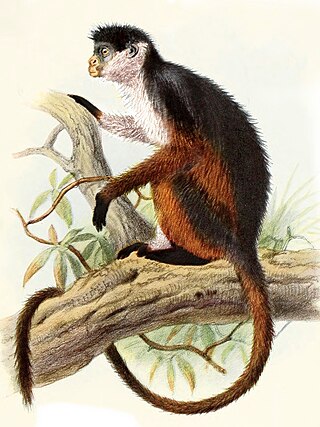
The Zanzibar red colobus is a species of red colobus monkey endemic to Unguja, the main island of the Zanzibar Archipelago, off the coast of Tanzania. It is also known as Kirk's red colobus after Sir John Kirk, the British Resident of Zanzibar who first brought it to the attention of zoological science. It is now classified as an endangered species and in the mid-1990s was adopted as the flagship species for conservation in Zanzibar. The population is still decreasing, and conservationists are attempting to work with the local government to devise a proper, effective strategy to protect the population and habitat. Challenges include the species' habitat, which is limited to the archipelago. The species has been reclassified three times; it was previously in the genus Colobus, then in the genus Procolobus, and later in the genus Piliocolobus.

Red colobuses are Old World monkeys of the genus Piliocolobus. It was formerly considered a subgenus within the genus Procolobus, which is now restricted to the olive colobus. They are closely related to the black-and-white colobus monkeys, and some species are often found in groups with the blue monkey. The western red colobus is frequently hunted by the common chimpanzee.

Miss Waldron's red colobus is a species of the red colobus native to West Africa. It had previously been described as a subspecies of the western red colobus, P. badius. It has not been officially sighted since 1978 and was considered extinct in 2000. However, new evidence suggests that a very small number of these monkeys may be living in the southeast corner of Côte d'Ivoire. The IUCN Red List notes Miss Waldron's red colobus as critically endangered.

The western red colobus, also known as the bay red colobus, rust red colobus or Upper Guinea red colobus, is a species of Old World monkey in West African forests from Senegal to Ghana. All other species of red colobuses have formerly been considered subspecies of P. badius. It is often hunted by the common chimpanzee. In 1994, western red colobus monkeys infected many chimpanzees with Ebola virus when the chimpanzees hunted the monkeys as prey.

The Tana River mangabey is a highly endangered species of primate in the family Cercopithecidae. Some authorities have included the taxa agilis and sanjei as subspecies of this species, while others award these full species status.

The Udzungwa red colobus, also known as the Uzungwa red colobus or Iringa red colobus, is a species of primate in the family Cercopithecidae. It is endemic to riverine and montane forest in the Udzungwa Mountains in Kilolo District of Iringa Region in Tanzania. It is threatened by habitat loss.

Pennant's colobus or Pennant's red colobus is a species of tree-dwelling primate in the family Cercopithecidae. It is endemic to tropical Central Africa. Three subspecies have traditionally been recognised but its distribution is peculiarly disjunct and has been considered a biogeographical puzzle, with one population on the island of Bioko, a second in the Niger River Delta in southern Nigeria, and a third in east-central Republic of Congo. It is found in rainforests and marshy forests. It is threatened by habitat loss and hunting for bushmeat.

The olive colobus monkey, also known as the green colobus or Van Beneden's colobus, is a species of primate in the family Cercopithecidae. Its English name refers to its dull olive upperparts. It is the smallest example of all colobine monkeys and is rarely observed in its natural habitat because of its cryptic coloration and secretive nature. It is found in the rain forests of West Africa, ranging from southern Sierra Leone to Nigeria. The IUCN Red List classifies the olive colobus as vulnerable, with the cause of its decline attributed to habitat loss and hunting. Though much of the land within the range of the olive colobus has been affected by human activities, it retains its ability to thrive in small degraded forest fragments.
The Tana River Primate National Reserve is a former 170 square kilometres (66 sq mi) national wildlife reserve in south-eastern Kenya. It existed from 1976 to 2007.

Preuss's red colobus is a red colobus primate species endemic to the Cross-Sanaga Rivers ecoregion. An important population occurs in Korup National Park, Southwest Province, Cameroon, but the species' distribution is localized. The species is considered present in adjacent Cross River National Park - Oban Division in Nigeria and hunter reports suggest that few groups remain in Nkwende Hills and Nta Ali Forest Reserve in the broader Korup region. A population is also present in Ebo forest, Littoral Province of Cameroon.

Thollon's red colobus, also known as the Tshuapa red colobus, is a species of red colobus monkey from the Democratic Republic of the Congo and lower Republic of the Congo. It is found south of Congo River and west of Lomami River. It had once been considered a subspecies of the P. badius. It was recognised as a distinct species by Dandelot in 1974, and this was followed by Groves in 2001, while others have suggested it should be considered a subspecies of P. rufomitratus.

The Ugandan red colobus or ashy red colobus is an endangered species of red colobus monkey, recognised as a distinct species since 2001. There is disagreement however over taxonomy with many considering the Ugandan red colobus to be a subspecies. The Ugandan red colobus is an Old World monkey which is found in five different locations across Uganda and Tanzania.

The World's 25 Most Endangered Primates is a list of highly endangered primate species selected and published by the International Union for Conservation of Nature (IUCN) Species Survival Commission (SSC) Primate Specialist Group (PSG), the International Primatological Society (IPS), Global Wildlife Conservation (GWC), and Bristol Zoological Society (BZS). The IUCN/SSC PSG worked with Conservation International (CI) to start the list in 2000, but in 2002, during the 19th Congress of the International Primatological Society, primatologists reviewed and debated the list, resulting in the 2002–2004 revision and the endorsement of the IPS. The publication was a joint project between the three conservation organizations until the 2012–2014 list when BZS was added as a publisher. The 2018–2020 list was the first time Conservation International was not among the publishers, replaced instead by GWC. The list has been revised every two years following the biannual Congress of the IPS. Starting with the 2004–2006 report, the title changed to "Primates in Peril: The World's 25 Most Endangered Primates". That same year, the list began to provide information about each species, including their conservation status and the threats they face in the wild. The species text is written in collaboration with experts from the field, with 60 people contributing to the 2006–2008 report and 85 people contributing to the 2008–2010 report. The 2004–2006 and 2006–2008 reports were published in the IUCN/SSC PSG journal Primate Conservation,, since then they have been published as independent publications.

The Niger Delta red colobus is a critically endangered species of colobus monkey endemic to the western part of the Niger Delta. It is threatened by hunting and habitat loss.
The Tana River Delta Ramsar Site is a wetland on the Tana River protected under the Ramsar Convention located in the Coast Province of Kenya. It was gazetted as Kenya's 6th Ramsar Site.

Bouvier's red colobus is a species of colobus monkey rediscovered in the Republic of the Congo in 2015, after four decades without a confirmed sighting.

Temminck's red colobus is a type of red colobus monkey from the Gambia, Casamance, Guinea-Bissau and northwestern Guinea. It has historically been regarded as a subspecies of the western red colobus, and the Integrated Taxonomic Information System and Mammal Diversity Database both maintain this classification, but many less recent taxonomies classify it as a separate species.

Foa's red colobus or the Central African red colobus, is a species of red colobus monkey found in the Democratic Republic of the Congo.















